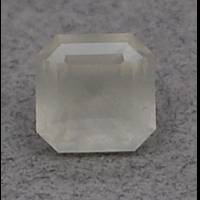Witherite

Rosiclare, Hardin County, Illinois, USA
2.74 carats
© Rarestone.com
Crystals are always twinned. Facetable pieces are usually small, gem rough rarely exceeds 5 grams. The translucent material is cut into cabochons.
Witherite dust is toxic, it is dangerous to inhale it.
Witherite Gemstones by Colour
This table shows the variety of hues this gemstone can be found in. Click on a photo for more information.
Witherite Gemstones by Size
This table shows distribution of Witherite gemstone sizes that are listed on this site. This can give a good indication as to the general availability of this gemstone in different sizes.
Contributed photos
Lightest:1.43 cts
Heaviest:2.74 cts
Average:2.08 cts
Total photos:2
Do you have a larger Witherite? Why not upload a photo?
| General Information | |||||||
|---|---|---|---|---|---|---|---|
| Chemical Formula |
| ||||||
| Physical Properties of Witherite | |||||||
| Mohs Hardness | 3 to 3.5, Gemstones of the world (2001) More from other references | ||||||
| Specific Gravity | 4.27 to 4.35, Gemmological Tables (2004) More from other references | ||||||
| Cleavage Quality | Distinct, Gemmological Tables (2004) More from other references | ||||||
| Fracture | Uneven, Gemstones (2009) | ||||||
| Optical Properties of Witherite | |||||||
| Refractive Index | 1.529 to 1.680, Gemmological Tables (2004) More from other references | ||||||
| Optical Character | Biaxial/-, Gemmological Tables (2004) More from other references | ||||||
| Birefringence | 0.148, Gemmological Tables (2004) More from other references | ||||||
| Pleochroism | Nil, Gemstones (2009) | ||||||
| Dispersion | Low, Gemstones (2009) | ||||||
| Colour | |||||||
| Colour (General) | Yellowish-white to colourless, Gemstones of the world (2001) More from other references | ||||||
| Transparency | Transparent,Translucent,Opaque, Gemmological Tables (2004) More from other references | ||||||
| Lustre | Vitreous,Waxy, Gemstones of the world (2001) More from other references | ||||||
| Fluorescence & other light emissions | |||||||
| Fluorescence (General) | Fluorescent and phosphorescent under UV, Handbook of mineralogy (2001) | ||||||
| Fluorescence (Short Wave UV) | May show a green or yellow fluorescence with phosphorescence, Gems, Sixth Edition (2006) | ||||||
| Fluorescence (X-RAY) | Fluorescent and phosphorescent under X-rays, Handbook of mineralogy (2001) | ||||||
| Crystallography of Witherite | |||||||
| Crystal System | Orthorhombic, Gemmological Tables (2004) More from other references | ||||||
| Habit | Botryoidal to spherical fibrous or granular masses, Gems, Sixth Edition (2006) More from other references | ||||||
| Geological Environment | |||||||
| Where found: | Witherite occurs in hydrothermal veins as a low-temperature mineral, Gems, Sixth Edition (2006) More from other references | ||||||
| Further Information | |||||||
| Mineral information: | Witherite information at mindat.org | ||||||
| Significant Gem Localities | |||||||
| |||||||

